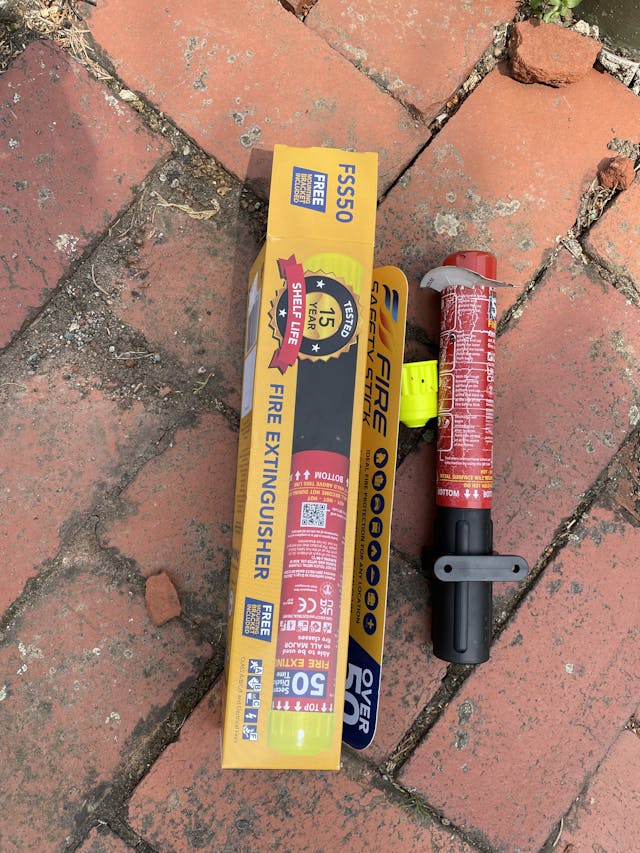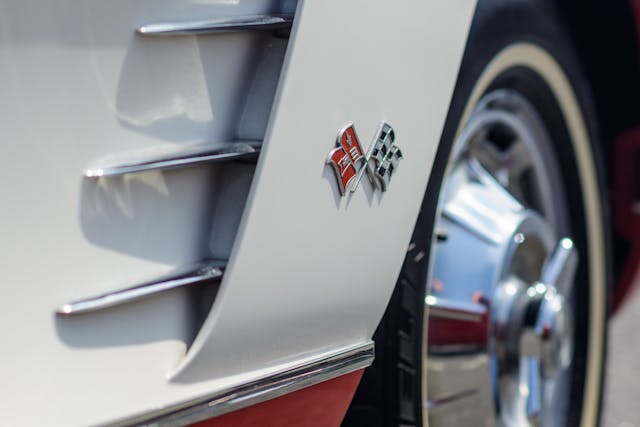How I saved my neighbor’s vintage Corvette from death by fire
It was a regular Saturday. I was tinkering with a sticky carburetor float on my Lotus Esprit when a neighbor pulled up in his mint 1959 Chevrolet Corvette.
We got to talking, bonding over the pitfalls of fiberglass bodywork, and other assorted highs and lows of the old car ownership. We exchanged numbers and agreed to head out on an early Sunday morning coffee run in our classics.
The weather was hot. When he went to restart the Vette it just wouldn’t play ball. We wondered if it was flooded or the high temperatures were causing a fuel evaporation problem. Talk, however, is cheap and it was clear that he couldn’t leave his car in the road, so my wife and I began to roll it gently to the curb.
As we pushed, ominous black smoke started spewing from under the hood. My neighbor hopped out and popped the engine cover. Flames leapt out from the edges and I shouted for him to close the hood, while I sprinted back to the Esprit to grab an extinguisher.
Specifically, I grabbed a recently-purchased Fire Safety Stick, which had been recommended by a fellow Esprit enthusiast. Lighter (just 7.6 ounces) and more compact than a regular powder extinguisher, the stick is not unlike a flare, but with the opposite effect.

I rapidly read the instructions, removed the safety cap and struck the top of the stick with the igniter. Inside, the triggered chain reaction caused the stick to emit a powerful spray of nitrogen and potassium free radicals, which starve any fire of oxygen.
Mr. Corvette (he prefers to keep his name out of it) opened the hood again and I pointed the stick at the air filter where the flames were spewing out. He then grabbed it off me to run around the other side of the car and finish the job. Within a minute the fire was out, and a near-$200,000 vehicle was saved.
Amazingly, there was only a small amount of blistering on the hood from the heat. Even more remarkably, when the owner had to move the car a day later it started on the button.

The people behind the Fire Safety Stick (sold as Element in the U.S.A.) told me that’s down to the fact that the product leaves almost no residue behind.
Andrew Robinson from Argento Global Solutions, the company that imports the stick in the U.K., explains that’s why many motorsport teams have now started carrying Fire Safety Sticks in addition to traditional plumbed-in extinguisher systems.
The technology, he explained, was actually invented in Soviet Russia during the space race, but it wasn’t until 20 years ago or so that an Italian company bought the rights and began manufacturing and selling the devices.
Having seen the stick in action, I immediately ordered another and highly recommend you do the same. Meanwhile, my neighbor, who has a collection of 11 classics, has probably become their biggest customer.
***
Check out the Hagerty Media homepage so you don’t miss a single story, or better yet, bookmark it. To get our best stories delivered right to your inbox, subscribe to our newsletters.



Maybe Hagerty should offer these at a discount to customers – could save them a bundle by minimizing damage in the event of a fire.
Freakin’ genius idea!
By the way…same price on Amazon, but free shipping.
How about this…Hagerty agrees to replace it if used to extinguish a fire of their insured vehicle.
I watched some videos of the Element extinguisher on YouTube. The results were pretty mixed.
I’ve seen those mixed reviews, but seems it would work well for something like an interior under the dash electrical fire (confined space), which would otherwise create an awful mess if you used a dry powder extinguisher.
After reading the story about the Extreme, I got curious about what other options may be out there. Personally I have a Halogen extinguisher in my ’62 Vette but I am not so sure that it would be enough in a real inferno. Therefor the interest is now peaked for a backup and the Element seems like a winner but how about one of these? The Jogoswall automatic car fire extinguishers ???
https://www.amazon.com/Jogoswall-Automatic-Extinguisher-0-24lbs-extinguishers/dp/B095S3L4GT/ref=asc_df_B095S3L4GT/?tag=hyprod-20&linkCode=df0&hvadid=533224879637&hvpos=&hvnetw=g&hvrand=13579431416373060452&hvpone=&hvptwo=&hvqmt=&hvdev=c&hvdvcmdl=&hvlocint=&hvlocphy=9031917&hvtargid=pla-1382786915250&psc=1
And now this too: Oy vey, Hagerty should do a story on all options…
https://www.amazon.com/dp/B0C22YBJVW/ref=sspa_dk_detail_0?psc=1&pd_rd_i=B0C22YBJVW&pd_rd_w=v3doH&content-id=amzn1.sym.d81b167d-1f9e-48b6-87d8-8aa5e473ea8c&pf_rd_p=d81b167d-1f9e-48b6-87d8-8aa5e473ea8c&pf_rd_r=TM82PRG3C9ZWMQDYMFC2&pd_rd_wg=OZBrp&pd_rd_r=34c62960-5417-41c8-956d-111311afc3b4&s=hi&sp_csd=d2lkZ2V0TmFtZT1zcF9kZXRhaWxfdGhlbWF0aWM&spLa=ZW5jcnlwdGVkUXVhbGlmaWVyPUE5N1hFS1ZXVVY0VzUmZW5jcnlwdGVkSWQ9QTA3MDYxOTgxTU1ON1YzMU9JTFdGJmVuY3J5cHRlZEFkSWQ9QTAyNzY1MDIxTFJYTVBISTVGNUdEJndpZGdldE5hbWU9c3BfZGV0YWlsX3RoZW1hdGljJmFjdGlvbj1jbGlja1JlZGlyZWN0JmRvTm90TG9nQ2xpY2s9dHJ1ZQ==
I have two Jogowalls installed in my engine bay of my 66 SS 396. They are a very small and unobtrusive fire suppression solution. I also have an element fire stick mounted under my dash.
Looked it up very pricey at 100+ bucks, could buy a Halon equivalent cheaper, not worth the money.
I’ve been shopping for a decent Halon, where are you purchasing from and getting that kind of pricing?
I had a similar experience one time; I was in the hunt for a 4 door dually tow pig and had spotted a clean late model used one at a local dealer. After the initial inspection I asked to take it out for a short drive, I looked down at the fuel gauge and was surprised to see both tanks were full. I had been driving about 15 minutes and had turned back towards the dealership when the truck died unexpectedly. I determined that it had run out of gas in spite of the “Full” mark on the gauge.
I hoofed it two miles down the interstate to the nearest civilization and called the dealership and awaited rescue. He sheepishly admitted that he had “forgotten” to tell me the gas gauge didn’t work. As he arrived at the roadside he immediately poured most of the gas from a 2 gallon can into the front tank and then told me to pop the hood so he could “prime the carburetor”. I told him that this particular vehicle had tank mounted electric pumps and that priming wasn’t necessary, he insisted so I relented and opened the hood.
He removed the air cleaner lid and poured some fuel into the carburetor and told me to turn it over. When I hit the key it of course spit up thru the carb a little which started the show. He’s dancing around by the roadside screaming “what should I do?” I first told him to throw some dirt into it to put out the fire which he started to do but I stopped him and told him to take off his shirt and beat the flames out with it. At first he hesitated and then finally tore off his shirt. Just as he was taking his first swing with his shirt I reached into the truck and bumped the engine over sucking the flames back into the engine.
He accused me of knowing that would happen all along and that I was just trying to get even with him for making me walk two miles in the July Oklahoma weather to which I admitted guilt..
I did end up buying the truck after they fixed the gas gauge. I used to laugh every time I drove by that dealership in that truck.
The procedure is: Remove the air cleaner; pour some gas into the carb; REPLACE THE AIR CLEANER; start the engine.
I have a fire stick mounted under the dash in my ’66 SS 396. More importantly, I have two tiny automatic fire extinguishers installed on the interior of my hood, pointing at the engine. (Jogoswall automatic fire extinguisher, $44.99 Amazon) They deploy automatically with the same type of powder as the fire stick.
I don’t work for Jogoswall, and I am very impressed with their products.
170 degree deployment?
That’s pretty low.
Air flowing through my radiator is 165-170.
Not suitable for Phoenix, I guess.
That’s 170 C (338 F). to be clear.
A battery disconnect can also be useful in the event of an electrical short fire.
I followed the smell of burning brakes for 3 miles up I 71 from Columbus Ohio before I came upon the semi with a burning wheel hub. We flagged him to stop on the roadside. His extinguisher was OK but ran out, but my element stopped the fire while my wife called 911. Forgetting the truck and it’s contents…the Element saved a 10 mile traffic backup from a fully engulfed semi. Fire arrived after we had cracked a couple cold ones…Cokes!
As with anything – before buying, do your ‘due diligence’ first – Look through complete reviews online, ‘youtube’, etc.. Especially something that you may well desperately need, to protect your treasures & investments..
Very interesting product. I will look into this.
200K for a ’59 ‘vette??
That’s pretty high doncha think?
Sounds like the story originates in the UK, maybe Vettes are worth more there than your country of origin?
My only observation:
” I rapidly read the instructions, removed the safety cap and struck the top of the stick with the igniter. ”
I remember the first time I bought a fire extinguisher. The first thing I did was read how to use it and commit it to memory. Do you really want to be reading the directions in the middle of a fire? It’s like the EMTs showing up while you are having a heart attack, with a defibrillator, and saying: give me a minute while I read the directions to figure out how to use this thing. 🙂
Most (if not all!) portable AEDs tell you exactly what to do (audio – step by step) once you turn them on.
Always be prepared for a fire! Great job!
Having to read the instructions on an unfamiliar fire extinguishing device doesn’t sound great though. I’ll stick with my extinguisher since nearly everyone knows how to use one.
I’ll give up the extra 2 cu in for the added versatility.
This seems like a weak attempt to sell a product. Shame on Hagerty.
Heaven forbid an insurance agency recommend a product that they have real first-hand positive experience that could save it’s clients the lose of time, money, and heartache. Think of the children!!
So where’s my Hagerty discount?